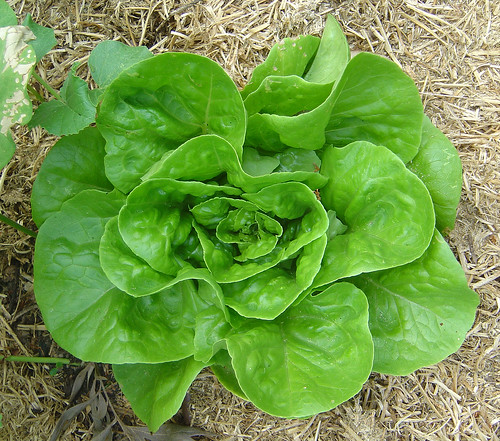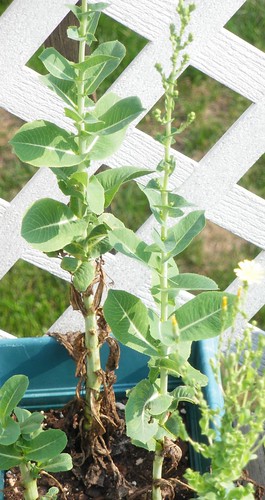Cropedia:Head Lettuce
Head Lettuce (Lactuca sativa)
" "
"
Years grown at UBC Farm/LFSOG: # 8/0
- Common varieties grown include Buttercrunch, Continuity, Red Butterworth, and Speckled Butterhead, all of which can be found at West Coast Seeds.
Growing conditions
[ 1 ]Lettuce grows best in cool weather, during the spring and fall. It is recommended to start sowing seeds after any chance of frost has past, and plant every 2-3 weeks for a continuous harvest. Mid-August plantings, with the benefit of added protection, can stretch the harvest into winter.
Seeding: Lettuce can be direct seeded, or started indoors and raised as transplants. Either way, plant the seeds on the surface and gently pat them into the soil (requires light to germinate). Seeds sprout in 2-14 days, depending on soil temperature.
- It should be noted that outdoors, they do not sprout well when the temperature is over 21 C (70 F), typically during July and August. To overcome this problem, called thermal dormancy, sprout lettuce seeds indoors in a cool area, or pre-sprout by placing the seeds on a damp paper towel, in a plastic bag put in the fridge for a few days. In optimal conditions, at least 80% of seeds will germinate.
Bolting:

Source: [1]
Head Lettuce bolts in the heat of mid-summer, producing its flower head. This is usually undesirable unless you wish to save the seed, as once this happens the lettuce will become bitter. To help minimize this, keep your lettuce watered well and provide shading from mid-day sun.
Seasonality
Spring through Fall. Winter if protection is provided.
Nutritional Information
| Nutrition Facts/Valeur Nutritive | |
|---|---|
| Serving Size: 72 g | |
| Amount Per Serving | %Daily Value* |
| Calories 10 (Calories from Fat 1) | |
| Total Fat 0g | 0% |
| Saturated Fat 0g | 0% |
| Trans Fat 0g | |
| Cholesterol 0mg | 0% |
| Sodium 7mg | 0% |
| Total Carbohydrate 2g | 1% |
| Dietary Fiber 1g | 3% |
| Sugars 1g | |
| Protein 1g | |
| Vitamine A | 7% |
| Vitamine C | 3% |
| Calcium | 1% |
| Iron | 2% |
| * % Daily value based on a 2000 calorie diet | |
- It is reported that the darker green leaves contain six times more vitamin C and eight times more Vitamin A then the lighter leaf varieties [ 2 ].
Recipes
Cut a large head of lettuce in half. Set aside the largest and strongest of the leaves as your “bowl”. Inside the lettuce bowl fill with lettuce pieces. Try to use a variety of head lettuce types for added colour and interest. At this stage add any of your favourite local and seasonal veggies. Adding coarsely chopped fresh herbs will add flavour and even more vitamins. Drizzle with olive oil and lime or your favourite vinegar. Top with edible flowers (cornflower, calendula etc...) and serve immediately.
Additional usage inventory
Medicinal Information:
- Scholarly sources: Recently, head lettuce is being studied for its analgesic and anti-inflammatory properties [ 3 ].
- Reported therapeutic effects range from uses as diuretics, to treatments for respiratory and digestive track ailments. Further information can be found at Botanical Online.
Academic connections
Notes from the UBC Farm (2010) [ 4 ]: UBC Farm is hoping to increase production of head lettuce. It’s a challenge to to grow well due to the fact that it bolts readily/gets bitter in the heat; then in the cool season, it's prone to downy mildew. Bottom rots can be an issue in the intermediate periods. Cabbage loopers, aphids, and wireworms are all pest problems at times. Because it takes longer to mature than baby leaf lettuces, head lettuce is also more of a challenge in terms of weed control. Growing from transplants is a way to address this, but that's an additional work in itself.
It is also being considered for cultivation for the LFSOG 2010 if harvest times and storage-ability can be improved. The UBC Farm and LFSOG follow the General Principles and Management Standards as outlined by the Certified Organic Association of BC.
When in season, you can find different varieties of head lettuce for sale at UBC Farm’s Saturday Markets.
References
Images
- Head Lettuce image: http://www.flickr.com/photos/30628871@N00/51788825/
- Nutitional Value fact image: http://www.nutritiondata.com/facts/vegetables-and-vegetable-products/2476/2
[1] West Coast Seeds. (2010). How to grow lettuce. Retrieved March 12, 2010, from http://www.westcoastseeds.com/how-to-grow/Vegetable-Seeds/Lettuce/
[2] Lettuce Food Facts (2010). Retrieved April 05, 2010 from http://www.bellybytes.com/foodfacts/lettuce_facts.html
[3] Mohammad Sayyah, Naghmeh H. and Mohammad K (2004). Analgesic and anti-inflammatory activity of Lactuca sativa seed extract in rats. Journal of Ethnopharmacology, Volume 92, Issues 2-3, June 2004, Pages 325-329.
[4] Timothy Carter, Production Coordinator , Centre for Sustainable Food Systems at UBC Farm, 2010. Email Received April 6th 2010.
Additional notes
Did You Know?:
- That typically is it best to harvest head lettuce at dawn or dusk, when photosynthetic activity is low. This minimizes wilting, thereby maximizing its storage time.
- To increase fridge life, try wrapping the head lettuce in a moist tea-towel and place it in a sealed plastic bag, blowing in air to minimize air space (reducing areas of bacterial growth) and to maintain crispness.